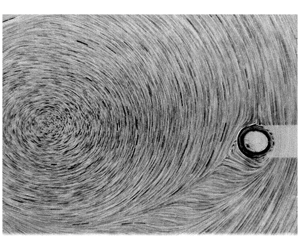Article contents
Wake behind contaminated bubbles in a solid-body rotating flow
Published online by Cambridge University Press: 10 December 2019
Abstract

A bubble injected into a flow rotating about a horizontal axis comes to an equilibrium location. The drag and lift exerted on the bubble can be measured and the bubble wake visualized (Rastello et al., J. Fluid Mech., vol. 624, 2009, pp. 159–178; Rastello et al., J. Fluid Mech., vol. 682, 2011, pp. 434–459; Rastello et al.,J. Fluid Mech., vol. 831, 2017, pp. 529–617). For a contaminated bubble, interface deformation remains limited. The bubble is freely rotating, which results in a complex separated wake, influenced by rotational flow and bubble spinning. The wake is described by analysing the near- and far-wake geometry and behaviour from laser-sheet visualizations, as a function of the relevant non-dimensional numbers: bubble Reynolds number  $Re$, Rossby number
$Re$, Rossby number  $Ro$, and non-dimensional spinning rate
$Ro$, and non-dimensional spinning rate  $\unicode[STIX]{x1D6FA}^{\ast }$. As the far-wake length increases with
$\unicode[STIX]{x1D6FA}^{\ast }$. As the far-wake length increases with  $Re$, it deflects towards the rotation axis of the flow, the deflection angle increasing with
$Re$, it deflects towards the rotation axis of the flow, the deflection angle increasing with  $Re$ and being twice the angle that would occur without deflection. Deflection is stronger for bubbles located close to the rotation axis of the flow (small
$Re$ and being twice the angle that would occur without deflection. Deflection is stronger for bubbles located close to the rotation axis of the flow (small  $Ro$). The far wake is more curved than the incoming streamlines. The near wake exhibits three distinct regimes as a function of
$Ro$). The far wake is more curved than the incoming streamlines. The near wake exhibits three distinct regimes as a function of  $Re$. For
$Re$. For  $Re\leqslant 140$, the near wake is structured by the bubble spinning. Its size is related to
$Re\leqslant 140$, the near wake is structured by the bubble spinning. Its size is related to  $\unicode[STIX]{x1D6FA}^{\ast }$ and grows faster with
$\unicode[STIX]{x1D6FA}^{\ast }$ and grows faster with  $Re$ than for a stationary sphere in a uniform flow. As the bubble spinning is saturating (
$Re$ than for a stationary sphere in a uniform flow. As the bubble spinning is saturating ( $140<Re\leqslant 240$), these differences vanish and
$140<Re\leqslant 240$), these differences vanish and  $Re$ dependences for the two situations becomes comparable. For
$Re$ dependences for the two situations becomes comparable. For  $Re>240$, wake instability generates a bubble precession that makes the near wake decrease rapidly for higher
$Re>240$, wake instability generates a bubble precession that makes the near wake decrease rapidly for higher  $Re$. These regimes coincide with the changes in the lift coefficients that we have noted in our studies.
$Re$. These regimes coincide with the changes in the lift coefficients that we have noted in our studies.
JFM classification
Information
- Type
- JFM Papers
- Information
- Copyright
- © 2019 Cambridge University Press
References
A correction has been issued for this article:
- 6
- Cited by
Linked content
Please note a has been issued for this article.

